- Table of Contents
-
- H3C Access Controllers Web-Based Configuration Guide(E3703P61 R2509P61 R3709P61 R2609P61 R3509P61)-6W103
- 00-Preface
- 01-About
- 02-Web overview
- 03-Login
- 04-Quick Start
- 05-Summary
- 06-Device
- 07-Network
- 08-AP Configuration
- 09-Wireless Service
- 10-WLAN Roaming Configuration
- 11-Radio Configuration
- 12-Authentication
- 13-Security
- 14-QoS Configuration
- 15-Advanced Settings
- 16-Stateful Failover Configuration
- 17-VPN
- 18-SSL VPN Configuration
- Related Documents
-
| Title | Size | Download |
|---|---|---|
| 11-Radio Configuration | 1.20 MB |
Contents
Configuring data transmit rates
Configuring 802.11a/802.11b/802.11g rates
Configuring the operating mode for an AP
Enabling spectrum analysis on a radio
Displaying interference device state
Displaying channel quality information
Manual channel adjustment configuration example
Automatic power adjustment configuration example
Radio group configuration example
Spectrum analysis configuration example
Configuring WLAN RRM
Radio overview
Radio frequency (RF) refers to electrical signals that can be transferred over the space to a long distance. 802.11b/g in the IEEE 802.11 standards operates at the 2.4 GHz band, 802.11a operates at the 5 GHz band, and 802.11n operates at both the 2.4 GHz and 5 GHz bands. Radio frequency is allocated in bands, each of which corresponds to a range of frequencies.
WLAN RRM overview
WLAN radio resource management (RRM) is a scalable radio resource management solution. APs collect radio environment information in real time. The AC analyzes the collected information. The AC makes radio resource adjustment configurations according to analysis results. APs implement the configurations made by the AC for radio resource optimization. Therefore, through information collection, information analysis, decision-making, and implementation, WLAN RRM delivers a real-time, intelligent, and integrated radio resource management solution. This enables a WLAN network to quickly adapt to radio environment changes and remain in a healthy state.
Dynamic frequency selection
A WLAN has limited working channels. Channel overlapping can easily occur. In addition, other radio sources such as radar and micro-wave ovens might interfere with the operation of APs. Dynamic frequency selection (DFS) can solve these problems.
With DFS, the AC selects an optimal channel for each AP in real time to avoid co-channel interference and interference from other radio sources.
The following conditions determine DFS:
· Error code rate—Physical layer error code and CRC errors.
· Interference—Influence of 802.11 and non-802.11 wireless signals on wireless services.
· Retransmission—APs retransmit data if they do not receive ACK messages from the AC.
· Radar signal detected on a working channel—The AC immediately notifies the AP to change its working channel.
If the first three conditions are met, the AC calculates the channel quality. The AP does not use the new channel until the channel quality difference between the new and old channels exceeds the tolerance level.
Figure 1 Dynamic channel adjustment

Transmit power control
Traditionally, an AP uses the maximum power to cover an area as large as possible. However, this method affects the operation of surrounding wireless devices. Transmit power control (TPC) is used to select a proper transmission power for each AP to satisfy both coverage and usage requirements.
Whether the transmission power of an AP is increased or decreased is determined by these factors: the maximum number of neighbors (detected neighbors that are managed by the same AC), the neighbor AP that performs power detection, and the power adjustment threshold. The latter two cannot be configured on the Web interface.
As shown in Figure 2, APs 1, 2, and 3 cover an area. When AP 4 joins, the default maximum neighbor number 3 (configurable) is reached. Among all the neighbors AP 2, AP 3, and AP 4 of AP 1, the signal strength of AP 4 is the third, so AP 4 becomes the AP that performs power detection. If AP 4 detects that the power of AP 1 is –75 dBm, which is lower than the default power adjustment threshold –65 dBm (configurable), AP 1 will increase its transmission power. If AP 4 detects that the power of AP 1 is –55 dBm, which is higher than the power adjustment threshold –65 dBm, AP 1 will decrease its transmission power.
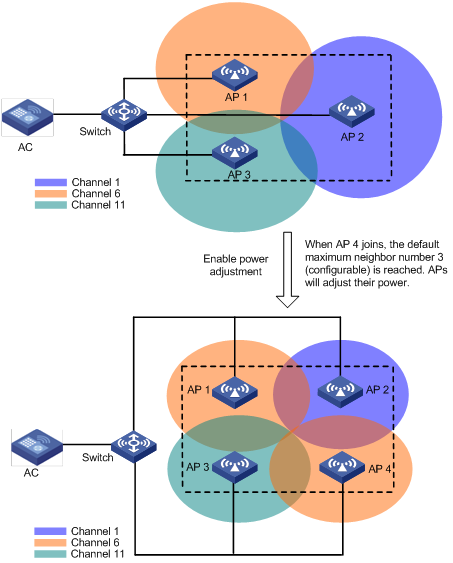
As shown in Figure 3, when AP 3 fails or goes offline, the other APs increase their transmission power to cover the signal blackhole.
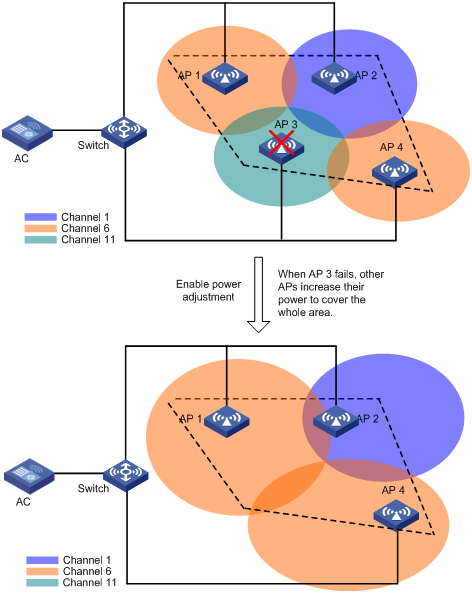
Spectrum analysis
WLAN systems operate on shared bands. Many devices, such as microwave ovens, cordless phones, and Bluetooth devices also operate on these bands and can negatively affect the WLAN systems.
The spectrum analysis feature is designed to solve this problem. Spectrum analysis delivers the following functions:
· Identifies five types of interferences and provides interference device reports.
· Calculates the number of interferences on each channel and average and worst channel quality, and provides channel quality reports.
· The AP collects Fast Fourier Transform (FFT) data, including frequency, FFT power, maximum power, and FFT duty cycle, and sends the data to the NMS through the AC.
· With RRM collaboration enabled, if the detected channel quality is lower than the threshold, the AC automatically adjusts the working channel upon detecting a channel with a higher quality.
Administrators can view the interference information on the AC, or view real-time spectrum analysis data on the NMS to locate and remove the interferences.
For more information about WIDS, see "Configuring WLAN security."
Configuring radios
Configuring radio parameters
1. Select Radio > Radio from the navigation tree.
2. Click the ![]() icon for the desired AP.
icon for the desired AP.
Figure 4 802.11a/b/g/n radio setup
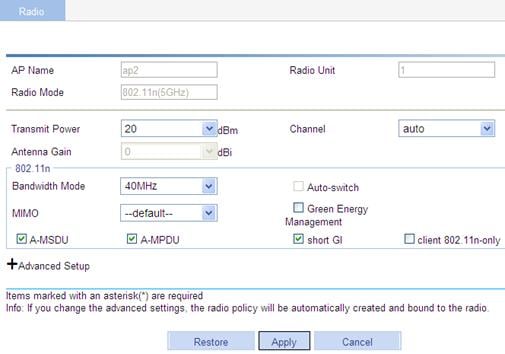
Figure 5 802.11ac radio setup

3. Configure the radio as described in Table 1.
|
Item |
Description |
|
|
AP Name |
Display the selected AP. |
|
|
Radio Unit |
Display the selected AP's radios. |
|
|
Radio Mode |
Display the selected AP's radio mode. |
|
|
Transmit Power |
Maximum radio transmission power, which varies with country codes, channels, AP models, radio modes and antenna types. If you adopt the 802.11n mode, the maximum transmit power of the radio also depends on the bandwidth mode. |
|
|
Channel |
Specify the working channel of the radio, which varies with radio types and country codes. The working channel list varies with device models. auto: The working channel is automatically selected. If you select this mode, the AP checks the channel quality in the WLAN network, and selects the channel of the best quality as its working channel. If you modify the working channel configuration, the transmit power is automatically adjusted. |
|
|
Antenna Gain |
Configure the gain for the third-party antenna. NOTE: This parameter is not configurable. |
|
|
802.11n |
The option is available only when the AP supports 802.11n and the radio mode is 802.11n. |
|
|
bandwidth mode |
802.11n can bond two adjacent 20-MHz channels together to form a 40-MHz channel. During data forwarding, the two 20-MHz channels can work separately with one acting as the primary channel and the other acting as the secondary channel. This provides a simple way of doubling the data rate. By default, the channel bandwidth of the 802.11n radio (5 GHz) is 40 MHz, and that of the 802.11n radio (2.4 GHz) is 20 MHz. 802.11ac bonds four adjacent 20-MHz channels together to form an 80-MHz channel, which increases the bandwidth and throughput. Like 802.11n, 802.11ac also ensures the throughput by increasing the channel usage rate. 802.11ac only supports 5 GHz. By default, the channel bandwidth of the 802.11ac radio is 80 MHz.
· If the channel bandwidth of the radio is set to 40 MHz, a 40 MHz channel is used as the working channel. If no 40 MHz channel is available, a 20 MHz channel is used. For the specifications, see IEEE P802.11n D2.00. · If the channel bandwidth of the radio is set to 80 MHz, an 80 MHz channel is used as the working channel when the corresponding center frequency is found. If no corresponding center frequency is found, the device attempts to use a 40 MHz channel. The 40 MHz is used if a channel that can be bound is found. If the device cannot find a channel that can be bound, it uses a 20 MHz channel. For the specifications, see IEEE P802.11acTM/D5.0. · If you modify the bandwidth mode configuration, the transmit power is automatically adjusted. |
|
|
Auto-switch |
Select this option to allow automatic bandwidth switch. If the channel bandwidth of an 802.11gn radio is 40 MHz, the automatic bandwidth switch function is not enabled by default. NOTE: For 802.11gn radios, only radios operating at 40 MHz support this option. 802.11an radios do not support this option. |
|
|
MIMO |
Configure the MIMO mode for a radio: · default—No MIMO mode is set. · 1x1—Enable a radio to transmit and receive 1 space stream at a time. · 2x2—Enable a radio to transmit and receive 2 space streams at a time. · 3x3—Enable a radio to transmit and receive 3 space streams at a time. NOTE: This option is available to only 802.11n radios supporting at least two spatial streams. |
|
|
Green Energy Management |
Select this option to enable energy saving. By default, this function is disabled. NOTE: · Only 802.11n radios support this option. · When this function is enabled, an AP automatically changes the MIMO mode of its radio to 1X1 if no clients are associated with the radio. |
|
|
client dot11n-only |
If you select the client dot11n-only option, only 802.11n clients are allowed to access the wireless network. To provide access for all 802.11a/b/g clients, you must disable this feature. For this feature to take effect, you must configure mandatory MCS indexes. For more information about mandatory MCS indexes, see "Configuring 802.11n MCS." |
|
|
A-MSDU |
Select the A-MSDU option to enable A-MSDU. Multiple MSDUs can be aggregated into a single A-MSDU. This reduces the MAC header overhead and improves MAC layer forwarding efficiency. At present, only A-MSDUs can be received.
When 802.11n radios are used in a mesh WLAN, make sure they have the same A-MSDU configuration. |
|
|
A-MPDU |
Select the A-MPDU option to enable A-MPDU. 802.11n introduces the Aggregated MAC Protocol Data Unit (A-MPDU) frame format. By using only one PHY header, each A-MPDU can accommodate multiple MPDUs which have their PHY headers removed. This reduces the overhead in transmission and the number of ACK frames to be used, and improves network throughput.
When 802.11n radios are used in a mesh WLAN, make sure they have the same A-MSDU configuration. |
|
|
short GI |
Select the short GI option to enable short GI. The 802.11a/g GI is 800ns. You can configure a short GI, 400 ns for 802.11n. The short GI increases the throughput by 10 percent. |
|
|
802.11ac |
The option is available only when the AP supports 802.11ac and the radio mode is 802.11ac. |
|
|
Access Type |
Select the client type that is allowed to associate with the radio. · all type—The radio allows 802.11a/an/ac clients to associate with it. · 802.11n and 802.11ac—The radio allows 802.11an/ac clients to associate with it. · 802.11ac—The radio allows 802.11ac clients to associate with it. By default, 802.11ac radio allows 802.11a/11an/ac clients to associate with it. For the client type configuration to take effect, you must configure 802.11ac NSS. For more information about 802.11ac NSS, see "Configuring 802.11ac NSS." |
|
4. Expand Advanced Setup.
Figure 6 Radio setup (advanced setup)
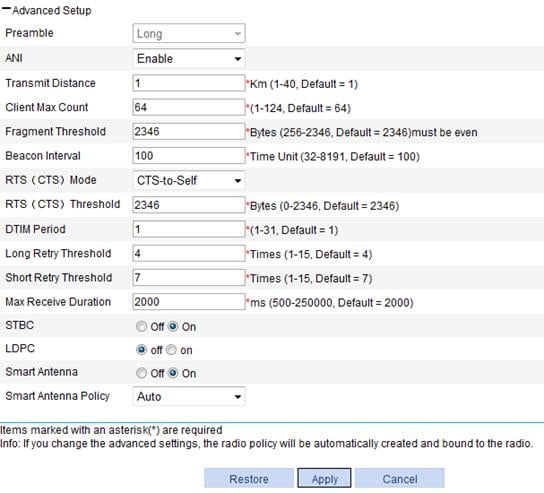
5. Configure the radio as described in Table 2, and click Apply.
|
Item |
Description |
|
Preamble |
Preamble is a pattern of bits at the beginning of a frame so that the receiver can sync up and be ready for the real data. · Short preamble—Short preamble improves network performance. Therefore, this option is always selected. · Long preamble—Long preamble ensures compatibility between access point and some legacy client devices. Therefore, you can select this option to make legacy client devices support short preamble. 802.11a/802.11n (5 GHz) does not support this configuration. |
|
ANI |
Adaptive Noise Immunity (ANI). After the ANI function is enabled, the device automatically adjusts the noise immunity level according to the surrounding signal environment to eliminate RF interference. · Enable—Enable ANI. · Disable—Disable ANI. |
|
Transmit Distance |
Maximum coverage of a radio. |
|
Client Max Count |
Maximum number of clients that can be associated with one radio. |
|
Fragment Threshold |
Specify the maximum length of frames that can be transmitted without fragmentation. When the length of a frame exceeds the specified fragment threshold value, it is fragmented. · In a wireless network where error rate is high, you can decrease the fragment threshold by a rational value. In this way, when a fragment of a frame is not received, only this fragment rather than the whole frame needs to be retransmitted, and the throughput of the wireless network is improved. · In a wireless network where no collision occurs, you can increase the fragment threshold by a rational value to decrease acknowledgement packets, and increase network throughput. Disable WMM before you configure the fragment threshold. |
|
Beacon Interval |
Interval for sending beacon frames. Beacon frames are transmitted at a regular interval to allow mobile clients to join the network. Beacon frames are used for a client to identify nearby APs or network control devices. |
|
RTS (CTS) |
There are two data collision avoidance mechanisms, RTS/CTS and CTS-to-Self. · RTS/CTS—In this mode, an AP sends an RTS packet before sending data to a client. After receiving the RTS packet, all the devices within the coverage of the AP will not send data within the specified time. Upon receiving the RTS packet, the client sends a CTS packet, ensuring that all the devices within the coverage of the client will not send data within the specified time. The RTS/CTS mechanism requires two frames to implement data collision avoidance, and has a higher cost. · CTS-to-Self—In this mode, an AP uses its IP address to send a CTS packet before sending data to a client, ensuring that all the devices within the coverage of the AP will not send data within the specified time. The CTS-to-Self mechanism uses only one frame to avoid data collision. However, if another device is in the coverage of the client, but not in the coverage of the AP, data collision still might occur. Compared with RTS/CTS, CTS-to-Self reduces the number of control frames. However, data collisions still occur when some clients are hidden and cannot receive the CTS frames sent by the AP. Therefore, the RTS/CTS mechanism can solve the data collision problem in a larger coverage than RTS/CTS. |
|
RTS (CTS) Threshold |
If a frame is larger than the RTS (CTS) threshold, the data collision avoidance mechanism is used. A smaller RTS/CTS threshold causes RTS/CTS packets to be sent more often, consuming more bandwidth. However, the more often RTS/CTS packets are sent, the quicker the system can recover from collisions. In a high-density WLAN, you can decrease the RTS threshold to reduce collisions in the network.
The data collision avoidance mechanism occupies bandwidth. Therefore, this mechanism applies only to data frames larger than the RTS/CTS threshold. |
|
DTIM Period |
Number of beacon intervals between delivery traffic indication message (DTIM) transmissions. The AP sends buffered broadcast/multicast frames when the DTIM counter reaches 0. |
|
Long Retry Threshold |
Number of retransmission attempts for unicast frames larger than the RTS/CTS threshold. |
|
Short Retry Threshold |
Number of retransmission attempts for unicast frames smaller than the RTS/CTS threshold if no acknowledgment is received for it. |
|
Max Receive Duration |
Interval for which a frame received by an AP can stay in the buffer memory. |
|
STBC |
· On—Enable STBC. · Off—Disable STBC. By default, Space-timed block coding (STBC) is enabled. With STBC enabled, the SNR of the receiver is increased and the reliability of data transmission is enhanced. STBC is applicable to WLAN access and mesh link. To reach the best performance, enable STBC on both the sending and receiving devices. STBC takes effect only when the number of antennas on the AP is greater than the spatial streams corresponding to the radio rate. Support for STBC depends on the device model. For more information, see "About the H3C Access Controllers Web-Based Configuration Guide." |
|
LDPC |
· On—Enable LDPC. · Off—Disable LDPC. By default, Low Density Parity Check Code (LDPC) is disabled. Support for LDPC depends on the device model. For more information, see "About the H3C Access Controllers Web-Based Configuration Guide." |
|
· On—Enable smart antenna. · Off—Disable smart antenna. Smart antenna can ensure high and stable bandwidths for clients within the coverage area, and decrease the interference among the AP and clients, avoiding interference caused by non-wireless devices. By default, smart antenna is enabled. Smart antenna takes effect only when the radio uses an internal antenna. You can select an internal antenna for the radio on the Radio > Antenna Switch page. Support for smart antenna depends on the device model. For more information, see "About the H3C Access Controllers Web-Based Configuration Guide." |
|
|
Smart Antenna Policy |
· Auto—Adopt auto policy, with high reliability policy for voice and video packets, and high throughput policy for other packets. · High Reliability—Adopt high reliability policy. · High Throughput—Adopt high throughput policy. By default, Auto is selected. Support for smart antenna policy depends on the device model. For more information, see "About the H3C Access Controllers Web-Based Configuration Guide." |
Enabling a radio
1. Select Radio > Radio from the navigation tree.
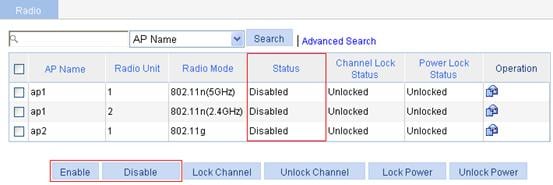
2. Select the box of the target radio.
3. Click Enable.
Locking the channel
1. Select Radio > Radio from the navigation tree.

2. Select the box of the target radio.
3. Click Lock Channel.
¡ Channel locking takes effect only when the AC adopts the auto mode. For more information about automatic channel adjustment, see "Configuring radio parameters."
¡ If you enable channel locking and then enable the radio, the AC automatically selects an optimal channel, and then locks the channel.
¡ When the AC detects any radar signals, it immediately selects another channel even if the current channel is locked, and then locks the new channel.
¡ If you lock the current channel first, and then enable channel adjustment, channel adjustment does not work because the current channel is locked. Therefore, before enabling channel adjustment, make sure the current channel is not locked. If you enable channel adjustment and then lock the current channel, the last selected channel is locked. For information about channel adjustment, see "Dynamic frequency selection." For more information about channel adjustment configuration, see "Setting parameters."
Locking the power
1. Select Radio > Radio from the navigation tree.
Figure 9 Locking the current power

2. Select the box of the target radio.
3. Click Lock Power.
¡ After you lock the power, the AC automatically sets the transmission power to the adjusted power value so that the AP can use the adjusted power when the AC is rebooted. For transmission power configuration, see "Configuring radio parameters."
¡ If you lock the current power first, and then enable power adjustment, power adjustment does not work because the power is locked. Therefore, before enabling power adjustment, make sure the current power is not locked. If you enable power adjustment, and then lock the current power, the last selected power is locked. For information about power adjustment, see "Transmit power control." For information about how to configure power adjustment, see "Setting parameters."
¡ After you lock the power, if the operating channel is adjusted, and the locked power is greater than the maximum power supported by the adjusted operating channel, the AC changes the power to the maximum power supported by the channel.
Configuring data transmit rates
Configuring 802.11a/802.11b/802.11g rates
1. Select Radio > Rate from the navigation tree.
Figure 10 Setting 802.11a/802.11b/802.11g rates

2. Configure 802.11a/802.11b/802.11g rates as described in Table 3, and click Apply.
|
Item |
Description |
|
802.11a |
Configure rates (in Mbps) for 802.11a. By default: · Mandatory rates—6, 12, and 24. · Supported rates—9, 18, 36, 48, and 54. · Multicast rate—Automatically selected from the mandatory rates. The transmission rate of multicasts in a BSS is selected from the mandatory rates supported by all the clients. |
|
802.11b |
Configure rates (in Mbps) for 802.11b. By default: · Mandatory rates—1 and 2. · Supported rates—5.5 and 11. · Multicast rate—Automatically selected from the mandatory rates. The transmission rate of multicasts in a BSS is selected from the mandatory rates supported by all the clients. |
|
802.11g |
Configure rates (in Mbps) for 802.11g. By default: · Mandatory rates—2, 5.5, and 11. · Supported rates—6, 9, 12, 18, 24, 36, 48, and 54. · Multicast rate—Automatically selected from the mandatory rates. The transmission rate of multicasts in a BSS is selected from the mandatory rates supported by all the clients. |
Configuring 802.11n MCS
Introduction to MCS
Configuration of mandatory and supported 802.11n rates is achieved by specifying the maximum Modulation and Coding Scheme (MCS) index. The MCS data rate table shows relations between data rates, MCS indexes, and parameters that affect data rates. Sample MCS data rate tables for 20 MHz and 40 MHz are shown in Table 4 and Table 5, respectively. For the entire table, see IEEE P802.11n D2.00.
Table 4 and Table 5 indicate that MCS 0 through 7 are for one single spatial stream, and when the MCS is 7, the data rate is the highest. MCS 8 through 15 are for two spatial streams, and when the MCS is 15, the data rate is the highest. For the whole table, see IEEE 802.11n-2009.
Support for MCS indexes depends on the device model.
Table 4 MCS index table (20 MHz)
|
MCS index |
Number of spatial streams |
Modulation |
Data rate (Mbps) |
|
|
800ns GI |
400ns GI |
|||
|
0 |
1 |
BPSK |
6.5 |
7.2 |
|
1 |
1 |
QPSK |
13.0 |
14.4 |
|
2 |
1 |
QPSK |
19.5 |
21.7 |
|
3 |
1 |
16-QAM |
26.0 |
28.9 |
|
4 |
1 |
16-QAM |
39.0 |
43.3 |
|
5 |
1 |
64-QAM |
52.0 |
57.8 |
|
6 |
1 |
64-QAM |
58.5 |
65.0 |
|
7 |
1 |
64-QAM |
65.0 |
72.2 |
|
8 |
2 |
BPSK |
13.0 |
14.4 |
|
9 |
2 |
QPSK |
26.0 |
28.9 |
|
10 |
2 |
QPSK |
39.0 |
43.3 |
|
11 |
2 |
16-QAM |
52.0 |
57.8 |
|
12 |
2 |
16-QAM |
78.0 |
86.7 |
|
13 |
2 |
64-QAM |
104.0 |
115.6 |
|
14 |
2 |
64-QAM |
117.0 |
130.0 |
|
15 |
2 |
64-QAM |
130.0 |
144.4 |
Table 5 MCS index table (40 MHz)
|
MCS index |
Number of spatial streams |
Data rate (Mbps) |
||
|
800ns GI |
400ns GI |
|||
|
0 |
1 |
BPSK |
13.5 |
15.0 |
|
1 |
1 |
QPSK |
27.0 |
30.0 |
|
2 |
1 |
QPSK |
40.5 |
45.0 |
|
3 |
1 |
16-QAM |
54.0 |
60.0 |
|
4 |
1 |
16-QAM |
81.0 |
90.0 |
|
5 |
1 |
64-QAM |
108.0 |
120.0 |
|
6 |
1 |
64-QAM |
121.5 |
135.0 |
|
7 |
1 |
64-QAM |
135.0 |
150.0 |
|
8 |
2 |
BPSK |
27.0 |
30.0 |
|
9 |
2 |
QPSK |
54.0 |
60.0 |
|
10 |
2 |
QPSK |
81.0 |
90.0 |
|
11 |
2 |
16-QAM |
108.0 |
120.0 |
|
12 |
2 |
16-QAM |
162.0 |
180.0 |
|
13 |
2 |
64-QAM |
216.0 |
240.0 |
|
14 |
2 |
64-QAM |
243.0 |
270.0 |
|
15 |
2 |
64-QAM |
270.0 |
300.0 |
For example, if you specify the maximum MCS index as 5 for mandatory rates, rates corresponding to MCS indexes 0 through 5 are configured as 802.11n mandatory rates.
· Mandatory rates must be supported by the AP and the clients that want to associate with the AP.
· Supported rates allow some clients that support both mandatory and supported rates to choose higher rates when communicating with the AP.
· Multicast MCS: Specifies 802.11n multicast data rates.
Configuring 802.11n rates
1. Select Radio > Rate from the navigation tree.
Figure 11 Setting 802.11n rate

2. Configure the 802.11n rate as described in Table 6, and click Apply.
|
Item |
Description |
|
Mandatory Maximum MCS |
Set the maximum MCS index for 802.11n mandatory rates.
If you select the client dot11n-only option, you must configure the mandatory maximum MCS. |
|
Multicast MCS |
Set the multicast MCS for 802.11n. The multicast MCS is adopted only when all the clients use 802.11n. If a non 802.11n client exists, multicast traffic is transmitted at a mandatory MCS data rate.
· If you configure a multicast MCS index greater than the maximum MCS index supported by the radio, the maximum MCS index is adopted. · When the multicast MCS takes effect, the corresponding data rates defined for 20 MHz with SGI disabled are adopted no matter whether the 802.11n radio operates in 40 MHz mode or in 20 MHz mode. |
|
Supported Maximum MCS |
Set the maximum MCS index for 802.11n supported rates. |
|
|
NOTE: When 802.11n radios are used in a mesh WLAN, make sure they have the same MCS configuration. |
Configuring 802.11ac NSS
Introduction to NSS
Configuration of 802.11ac radio rate is achieved by specifying the number of spatial streams (NSS). 802.11 ac uses very high throughput modulation and coding scheme (VHT-MCS) to indicate WLAN data rates. A VHT-MCS data rate table shows relations between data rates, VHT-MCS indexes, and parameters that affect data rates. In 802.11ac, the physical transmission rate upon specific parameters corresponding to the VHT-MCS index is determined by the VHT-MCS rate table and NSS. Sample VHT-MCS data rate tables for 20 MHz, 40 MHz, and 80 MHz are shown in Table 7, Table 8, and Table 9, respectively. For the entire table, see IEEE Draft P802.11ac_D5.0.
The value range for NSS is 1 to 8, and the value range for VHT-MCS in each NSS is 0 to 9.
|
|
NOTE: Support for NSS depends on the device model. |
Table 7 VHT-MCS rate table (20 MHz Nss =1)
|
VHT-MCS Index |
Modulation |
Data Rate (Mbps) |
|
|
800ns GI |
400ns GI |
||
|
0 |
BPSK |
6.5 |
7.2 |
|
1 |
QPSK |
13.0 |
14.4 |
|
2 |
QPSK |
19.5 |
21.7 |
|
3 |
16-QAM |
26.0 |
28.9 |
|
4 |
16-QAM |
39.0 |
43.3 |
|
5 |
64-QAM |
52.0 |
57.8 |
|
6 |
64-QAM |
58.5 |
65.0 |
|
7 |
64-QAM |
65.0 |
72.2 |
|
8 |
256-QAM |
78.0 |
86.7 |
|
9 |
not valid |
||
Table 8 VHT-MCS rate table (40 MHz Nss = 1)
|
MCS Index |
Modulation |
Data Rate (Mbps) |
|
|
800ns GI |
400ns GI |
||
|
0 |
BPSK |
13.5 |
15.0 |
|
1 |
QPSK |
27.0 |
30.0 |
|
2 |
QPSK |
40.5 |
45.0 |
|
3 |
16-QAM |
54.0 |
60.0 |
|
4 |
16-QAM |
81.0 |
90.0 |
|
5 |
64-QAM |
108.0 |
120.0 |
|
6 |
64-QAM |
121.5 |
135.0 |
|
7 |
64-QAM |
135.0 |
150.0 |
|
8 |
256-QAM |
162.0 |
180.0 |
|
9 |
256-QAM |
180.0 |
200.0 |
Table 9 VHT-MCS rate table (80 MHz Nss = 1)
|
MCS Index |
Modulation |
Data Rate (Mbps) |
|
|
800ns GI |
400ns GI |
||
|
0 |
BPSK |
29.3 |
32.5 |
|
1 |
QPSK |
58.5 |
65.0 |
|
2 |
QPSK |
87.8 |
97.5 |
|
3 |
16-QAM |
117.0 |
130.0 |
|
4 |
16-QAM |
175.5 |
195.0 |
|
5 |
64-QAM |
234.0 |
260.0 |
|
6 |
64-QAM |
263.3 |
292.5 |
|
7 |
64-QAM |
292.5 |
325.0 |
|
8 |
256-QAM |
351.0 |
390.0 |
|
9 |
256-QAM |
390.0 |
433.3 |
NSS is divided into the following types:
· Mandatory NSS—Mandatory rates must be supported by the AP and the clients that want to associate with the AP.
· Supported NSS—Supported NSS allow some clients that support both mandatory and supported NSS to choose higher rates when communicating with the AP.
· Multicast NSS—Multicast NSS allow some clients that support both mandatory and multicast NSS to transmit multicast data with configured multicast NSS.
The NSS value refers to a value range, starting from 0 and ending with the configured value. For example, if you enter 5, the value range for NSS is 0 to 5.
When configuring multicast rate for 802.11ac radio, you need to specify the multicast NSS and multicast VHT-MCS.
Configuring 802.11ac rates
1. Select Radio > Rate from the navigation tree.
Figure 12 Configuring 802.11ac rate

2. Configure the 802.11ac rate as described in Table 10, and click Apply.
|
Item |
Description |
|
Select Mandatory Maximum NSS and set the maximum 802.11ac mandatory NSS.
If you select the 802.11n and 802.11ac or 802.11ac option, you must configure the mandatory maximum NSS. |
|
|
Multicast NSS |
Set the multicast NSS for 802.11ac. The multicast NSS is adopted only when all the clients use 802.11ac. If a non 802.11ac client exists, multicast traffic is transmitted at a rate determined by the client type.
· If you configure a multicast NSS greater than the maximum NSS supported by the radio, the maximum supported NSS is adopted. · When the multicast NSS takes effect, the corresponding data rates defined for 20 MHz are adopted no matter whether the 802.11ac radio operates in 20 MHz mode, 40 MHz mode, or 80 MHz mode. |
|
Supported Maximum NSS |
Set the maximum NSS for 802.11ac supported rates. The supported maximum NSS must be equivalent to or larger than the mandatory maximum NSS. |
|
Multicast VHT-MCS |
Set the multicast VHT-MCS index value for 802.11ac radio. When configuring multicast rate for 802.11ac radio, specify the multicast NSS and multicast VHT-MCS index. |
Configuring channel scanning
For more information about active passive scanning, see "Configuring access services."
1. Select Radio > Channel Scan from the navigation tree.
Figure 13 Setting channel scanning

2. Configure channel scanning as described in Table 11, and click Apply.
|
Item |
Description |
|
Scan Mode |
Set the scan mode. · Auto—Legal channels with the scanning mode under country/region code are scanned. · All—All the channels of the radio band are scanned. |
|
Scan Non-802.11h Channel |
Some of 802.11h channels, also called radar channels, overlap some 802.11a channels. If the device operates on an overlapping channel, the service quality of the WLAN might be affected. With this function enabled, the device selects a working channel from non-802.11h channels belonging to the configured district code to avoid channel collision. Selecting the Scan Non-802.11h Channel option enables the function of scanning non-802.11h channels. By default, the scan mode is auto, that is, all channels of the country/region code being set are scanned. |
|
Scan Type |
Set the scan type. · Active—Active scanning requires an AP to send a probe request. This scanning mode enables an AP to discover devices more easily. · Passive—Passive scanning is used by a client when it wants to save battery power. Typically, VoIP clients adopt the passive scanning mode. For an AP that has the monitoring function: · Active—The AP simulates a client to send probe requests during the scanning process. · Passive—The AP does not send probe requests during the scanning process. If you set active scanning for the AP, it is more likely to discover devices in the WLAN. |
|
Scan Interval |
Set the scan report interval. · A longer scan interval enables an AP to discover more devices in the WLAN. · A shorter scan interval enables an AP to send scanning reports to an AC more frequently. If an AP has the monitoring function, the scan report interval will affect whether the scanning results can be processed in time and the frequency of message exchanges. Therefore, you need to set the interval correctly according to the actual network conditions. |
|
5GHz Excluded Channel/2.4GHz Excluded Channel |
To avoid selecting improper channels, you can exclude specific channels from automatic channel selection. The excluded channels will not be available for initial channel selection, DFS, and mesh DFS. This feature does not affect rogue detection, WIPS, and WIDS. Select a channel and add it to the 5GHz Excluded Channel or 2.4GHz Excluded Channel. By default, no channels exist in the 5GHz Excluded Channel or 2.4GHz Excluded Channel.
· The channel exclusion list is not restricted by the country/region code. You can add channels not supported by the country/region code to the list, and changing the country/region code does not change the channel list. The device will select an available channel from the channels supported by the country/region code and not in the channel exclusion list. When you configure this feature, do not add all channels supported by the country/region code to the channel exclusion list. · This feature takes effect only for initial channel selection, DFS, and mesh DFS. · If you add an automatically selected channel into the channel exclusion list, the AC disables the radio, enables the radio, and then selects an available channel from the channels supported by the country/region code and not in the channel exclusion list. · If you add an automatically selected primary channel to the channel exclusion list, the AC selects another available primary channel. If you add a secondary channel into the channel exclusion list in this case, the AC selects another secondary channel. If the AP cannot find an available secondary channel, no channels are available for the wireless, mesh, and WDS services. |
Configuring calibration
Executing channel persistence
Configuration guidelines
· Channel persistence is applicable to radios used for wireless access, and the radios must have channels.
· Channel persistence is not applicable to auto APs, nor APs operating in monitor mode.
· The device switches to a new channel if radar signals are detected on the channel, regardless of whether it is a persistent channel or not.
· If a radio is configured to automatically select its channel mode, the channel persistence operation does not take effect if no channel is selected.
· If a radio is configured to automatically select its channel mode and channel persistence is executed after a channel is selected, the device automatically saves the channel value through the Channel option on the Radio page. After AC reboots, AP continues to use the persistent channel.
· If channel persistence is executed on a locked channel, the channel is unlocked. The device automatically saves the channel value through the Channel option on the Radio page. After AC reboots, AP continues to use the persistent channel.
Configuration procedure
1. Select Radio > Calibration from the navigation tree.
2. Click the Operation tab.
3. Select the box of the target AP.
4. Click Channel Persistent.
Figure 14 Executing channel persistence

The device executes channel persistence on automatically selected or adjusted channels. After the AC reboots, the AP continues to use the persistent channel.
Configuring power persistence
Configuration guidelines
· Power persistence is applicable to radios used for wireless access.
· Power persistence is not applicable to auto APs, nor APs operating in monitor mode.
Configuration procedure
1. Select Radio > Calibration from the navigation tree.
2. Click the Operation tab.
3. Select the box of the target AP.
4. Click Power Persistent.
Figure 15 Configuring power persistence

The device executes power persistence on the adjusted power. If the adjusted power value is not the default value set through the Transmit Power option on the Radio page, the device automatically saves the power value. After the AC reboots, the AP continues to use the adjusted power.
Setting parameters
1. Select Radio > Calibration from the navigation tree.
2. Click the Parameters tab.
Figure 16 Setting channel calibration
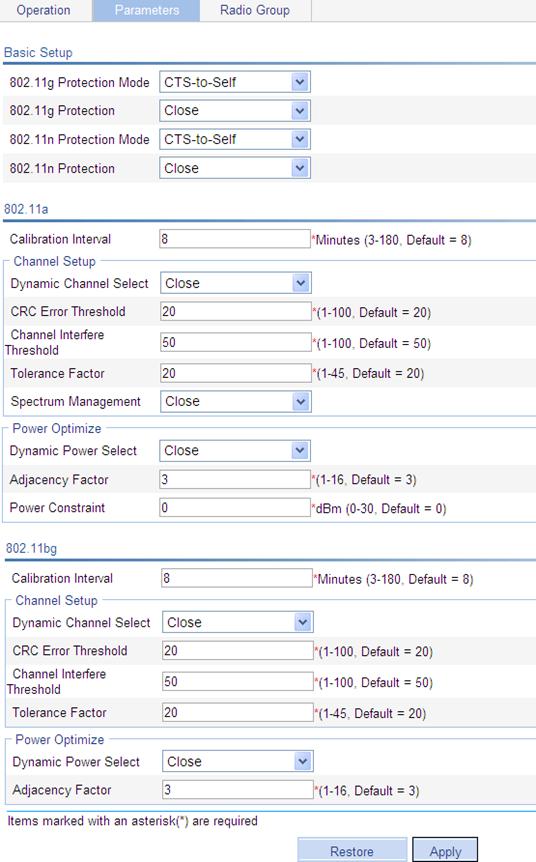
3. Configure channel calibration as described in Table 12, and click Apply.
|
Item |
Description |
|
|
Basic Setup |
802.11g Protection Mode |
· RTS/CTS—Use RTS/CTS mode to implement 802.11g protection. Before sending data to a client, an AP sends an RTS packet to the client, ensuring that all the devices within the coverage of the AP do not send data in the specified time after receiving the RTS packet. Upon receiving the RTS packet, the client will send a CTS packet again, ensuring that all the devices within the coverage of the client do not send data in the specified time. · CTS-to-Self—Use CTS-to-Self mode to implement 802.11g protection. When an AP sends packets to a client, it uses its IP address to send a CTS packet to inform the client that it will send a packet, ensuring that all the devices within the coverage of the AP do not send data in the specified time. |
|
802.11g Protection |
· 802.11b devices and 802.11g devices use different modulation modes, so 802.11g protection needs to be enabled for a 802.11g device to send RTS/CTS or CTS-to-self packets to 802.11b devices, which will defer access to the medium. · Enable—Enable 802.11g protection. · Close—Disable 802.11g protection. An AP running 802.11g uses the 802.11g protection function in the following two cases: · An 802.11b client is associated with it. · It detects APs or clients running 802.11b on the same channel.
· Enabling 802.11g protection reduces network performance. · Enabling 802.11g protection applies to the second case only, because 802.11g protection is always enabled for the first case. |
|
|
802.11n Protection Mode |
Both RTS/CTS and CTS-to-Self modes can be adopted. The implementation of the two modes is the same as 802.11g. |
|
|
802.11n Protection |
· Enable—Enable 802.11n protection. When non 802.11n wireless devices or non 802.11n clients exist within the coverage of the AP, you need to enable 802.11n protection. · Close—Disable 802.11n protection. |
|
|
Calibration Interval |
Channel and power calibration interval. A calibration interval takes effect on both mesh network channel calibration and channel and power calibration of wireless services. |
|
|
Channel Setup |
Follow these guidelines when configuring channel adjustment: · Before configuring channel adjustment, make sure the AC adopts the auto channel adjustment mode (for more information, see "Configuring radio parameters."). Otherwise, channel adjustment does not work. · If you lock the channel first, and then enable channel adjustment (by selecting Dynamic Channel Select), channel adjustment does not work because the channel is locked. Before enabling channel adjustment, make sure the channel is not locked. · If you enable channel adjustment and then lock the channel, the last selected channel is locked. For information about how to lock the channel, see "Locking the channel." |
|
|
Dynamic Channel Select |
· Close—Disable the DFS function. · Auto—With auto DFS enabled, an AC performs DFS for a radio when certain trigger conditions are met on the channel, and returns the result to the AP after a calibration interval (the default calibration interval is 8 minutes, which can be set through the Calibration Interval option). After that, the AC will make DFS decisions at the calibration interval automatically. · Manual—With one-time DFS configured for a radio, an AC performs DFS for the radio when certain trigger conditions are met on the channel, and returns the result to the AP after a calibration interval. After that, if you want the AC to perform DFS for the radio, you have to make this configuration again.
If you select the manual mode, click Calibration on the Calibration page every time you perform channel calibration. |
|
|
CRC Error Threshold |
Set the CRC error threshold value, in percentage. |
|
|
Channel Interference Threshold |
Set the channel interference threshold value, in percentage. |
|
|
Tolerance Factor |
A new channel is selected when either the configured CRC error threshold or interference threshold is exceeded on the current channel. However, the new channel is not applied until the quality of the current channel is worse than that of the new channel by the tolerance threshold. |
|
|
Spectrum Management |
· Enable—Enable spectrum management. · Close—Disable spectrum management. When spectrum management is enabled, the AP notifies its power capacity and power restriction on clients. |
|
|
Power Setup |
Follow these guidelines when configuring power adjustment: · If you lock the power first, and then enable power adjustment (by selecting Dynamic Channel Select), power adjustment does not work because the power is locked. Therefore, before enabling power adjustment, make sure the power is not locked. · If you enable power adjustment and then lock the power, the last selected power is locked. For information about how to lock the power, see "Locking the power." |
|
|
Dynamic Power Select |
· Close—Disable transmit power control (TPC). · Auto—With auto TPC enabled, the AC performs TPC for an AP upon certain interference and returns the result to the AP after a calibration interval (the default calibration interval is 8 minutes, which can be set through the Calibration Interval option). After that, the AC makes TPC decisions at the calibration interval automatically. · Manual—With one-time TPC configured, an AC performs TPC for the AP upon certain interference, and returns the result to the AP after a calibration interval (the default calibration interval is 8 minutes, which can be set through the Calibration Interval option). After that, if you want the AC to perform TPC for the AP, you have to make this configuration again.
If you select the manual mode, click Calibration on the Calibration page every time you perform channel calibration. |
|
|
Adjacency Factor |
Specify the neighbor APs that trigger automatic power adjustment. The neighbor APs are managed by the same AC. |
|
|
Power Constraint |
Enable the AC to notify all 802.11a clients to reduce their transmit power by a specified value. For example, if the power constraint is set to 5, the AC notifies 802.11a clients to decrease their maximum power by 5 dBm. By default, the transmit power for 802.11a radios is not restricted.
Enable spectrum management before configuring the power constraint; otherwise, the configuration does not take effect. |
|
Channel switching results in temporary service interruption, so use the channel calibration function with caution.
Configuring a radio group
With DFS or TPC configured for a radio, the AC calculates the channel quality or power of the radio at the calibration interval. When the result meets a trigger condition, the AC selects a new channel or power for the radio. In an environment where interference is serious, frequent channel or power adjustments might affect user access to the WLAN network. In this case, you can configure a radio group to keep the channel or power of radios in the group unchanged within a specified time. The channel and power of radios not in the radio group are adjusted correctly.
After a channel or power adjustment (auto or initial DFS or TPC), the channel or power of any radio in the radio group keeps unchanged within the specified holddown time. When the holddown time expires, the AC calculates the channel or power again. If the result meets a trigger condition, the channel or power is changed, and the new channel or power keeps unchanged within the specified holddown time. This mechanism continues.
|
|
NOTE: Before entering the Radio Group page, configure channel or power adjustment on the Parameters tab. |
1. Select Radio > Calibration from the navigation tree.
2. Click Radio Group.
3. Click Add.
The Radio Group page appears.
Figure 17 Configuring a radio group

4. Configure the radio group as described in Table 13, and click Apply.
|
Item |
Description |
|
Group ID |
ID of the radio group |
|
Description |
Description for the radio group. By default, a radio group has no description. |
|
Channel Holddown Interval |
Specify that the current channel keeps unchanged within the specified time after a channel adjustment (automatic or initial channel selection).
The AC immediately selects another channel when it detects any radar signals on the current channel, and then resets the channel holddown timer. |
|
Power Holddown Interval |
Specify that the current power keeps unchanged within the specified time after a power adjustment (automatic power adjustment). |
|
Radio List |
· Select the target radios from the Radios Available area, and then click << to add them into the Radios Selected area. · Select the radios to be removed from the Radios Selected, and the click >> to remove them from the radio group. |
Calibration operations
If RRM is not enabled, or the radio to be displayed works on a fixed channel, you can only view the work channel and the power of the radio on the Operations tab in the Radio > Calibration page. Other information such as interference observed and the number of neighbors is displayed when RRM is enabled, that is, dynamic power selection or automatic dynamic frequency selection is enabled. For the configuration of RRM parameters, see "Setting parameters."
Displaying channel status
1. Select Radio > Calibration from the navigation tree.
2. On the Operations tab, click the Channel Status tab.
3. Click the desired radio to enter the page for displaying channel status.

|
Item |
Description |
|
Channel NO |
Running channel. |
|
Neighbor Num |
Number of neighbors on a channel. |
|
Load (%) |
Load detected on a channel. |
|
Utilization (%) |
Channel utilization. |
|
Interference (%) |
Duration of all invalid packets detected on a channel. |
|
Packet Error Rate (%) |
Error rate for packets on a channel. |
|
Retransmission Rate (%) |
Retransmission rate on a channel. |
|
Radar Detect |
Radar detection status. |
Displaying neighbor information
1. Select Radio > Calibration from the navigation tree.
2. On the Operations tab, click the Neighbor Info tab.
3. Click the desired radio to enter the page for displaying neighbor information.
Figure 19 Neighbor information
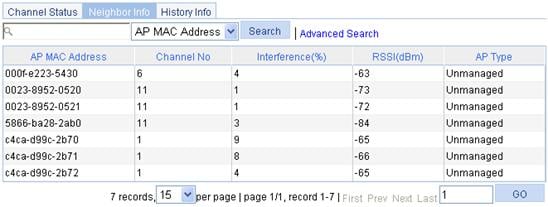
|
Field |
Description |
|
AP MAC Address |
MAC address of a neighbor AP. |
|
Channel No |
Running channel. |
|
Interference (%) |
Duration of all invalid packets detected on a channel. |
|
RSSI (dBm) |
Received signal strength indication (RSSI) of the AP, in dBm. |
|
AP Type |
AP type, managed or unmanaged. |
Displaying history information
History information is available only if channel switching or power adjustment occurs after RRM is enabled.
To display history information:
1. Select Radio > Calibration from the navigation tree.
2. On the Operations tab, click History Info.
3. Click the desired radio to enter the page for displaying neighbor information.
Figure 20 History information

Table 16 Field description
|
Field |
Description |
|
Radio |
Radio ID of the AP. |
|
Basic BSSID |
MAC address of the AP. |
|
Chl |
Channel on which the radio operates in case of the change of channel or power. |
|
Power |
Power of the radio in case of the change of channel or power. |
|
Load |
Load observed on the radio in percentage in case of the change of channel or power. |
|
Util |
Utilization of the radio in percentage in case of the change of channel or power. |
|
Intf |
Interference observed on the radio in percentage in case of the change of channel or power. |
|
PER |
Packet error rate observed on a channel, in percentage. |
|
Retry |
Percentage of retransmission happened on the radio before/after the change of channel or power. |
|
Reason |
Reason for the change of channel or power, such as interference, packets discarded, retransmission, radar or coverage. |
|
Date |
Date when the channel or power change occurred. |
|
Time |
Time when the channel or power change occurred. |
Selecting an antenna
1. Select Radio > Antenna Switch to select an appropriate antenna for the corresponding radio.
2. Select the antenna type for a specific radio from the Antenna list.
3. Click Apply.
Figure 21 Antenna switch
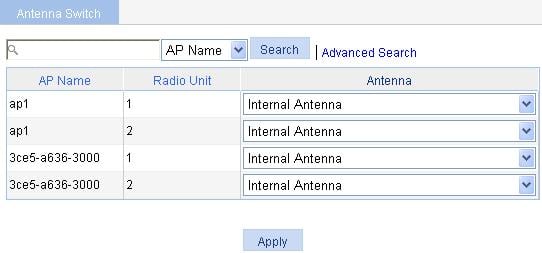
Configuring spectrum analysis
Support for this feature depends on the device model.
Configuring the operating mode for an AP
The channels that an AP can detect depend on the operating mode of the AP:
· When operating in normal mode, an AP can only detect interference devices and channel quality, and collect FFT data for its working channel.
· When operating in monitor or hybrid mode, the channels that an AP can detect depend on the scan channel command. If you configure the scan channel auto command, the AP detects interference devices and channel quality, and collects FFT data for the channels supported by the country code. If you configure the scan channel all command, the AP detects interference devices and channel quality, and collects FFT data for all channels.
For information about how to configure the operating mode for an AP, see "Configuring WLAN IDS."
|
|
NOTE: H3C recommends that you enable spectrum analysis for APs operating in monitor or hybrid mode. |
Configuring spectrum analysis
This section configures spectrum analysis on 2.4 GHz radios.
Select Radio > Spectrum Analysis from the navigation tree, and click 802.11bg.
Figure 22 Spectrum analysis
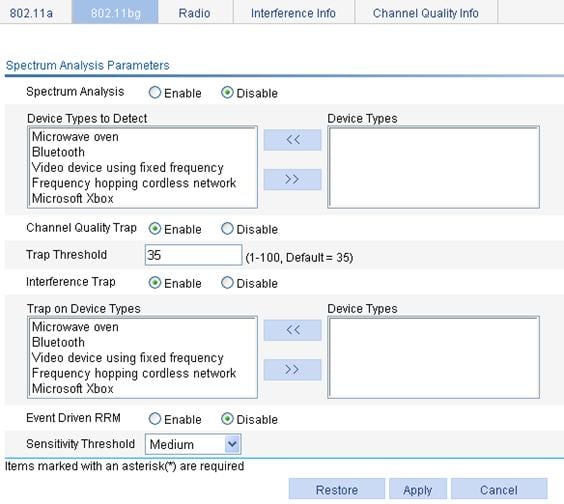
Enabling spectrum analysis
The AP begins to detect interferences and channel quality, and collects FFT data when spectrum analysis is enabled.
Table 17 Configuration items
|
Item |
Description |
|
|
Spectrum Analysis |
· Enable—Enable spectrum analysis. · Disable—Disable spectrum analysis. By default, spectrum analysis is disabled. |
Spectrum analysis takes effect only when enabled both globally and on a radio. |
|
Enable spectrum analysis on a radio |
||
|
Device Types to Detect |
Specify the device types to detect. · To add a device type to the Device Types area, select a device type in the Device Types to Detect area, and click <<. · To remove a device type from the Device Types area, select a device type in this area, and click >>. By default, all device types in the Device Types to Detect area are detected. |
|
Configuring event-driven RRM
This function enables the AC to start calculating the channel quality, and switch to a new channel with a higher quality when the channel quality is lower than the sensitivity level.
Table 18 Configuration items
|
Item |
Description |
|
Event Driven RRM |
· Enable—Enable event-driven RRM. · Disable—Disable event-driven RRM. By default, spectrum analysis does not trigger channel adjustment. |
|
Sensitivity Threshold |
· High—Specify the high sensitivity threshold. · Low—Specify the low sensitivity threshold. · Medium—Specify the medium sensitivity threshold. By default, the sensitivity threshold is medium. |
Enabling SNMP traps
This function enables the AC to send SNMP traps to the NMS when detecting an interference device or when detecting the channel quality is lower than the alarm threshold.
Table 19 Configuration items
|
Item |
Description |
|
Configure channel quality trap |
|
|
Channel Quality Trap |
· Enable—The AC sends SNMP traps to the NMS when the channel quality is lower than the threshold. · Disable—The AC does not send SNMP traps to the NMS when the channel quality is lower than the threshold. By default, the AC sends SNMP traps to the NMS when the channel quality is lower than the threshold. |
|
Trap Threshold |
Channel quality trap threshold. |
|
Configure interference device trap |
|
|
Interference Trap |
· Enable—The AC sends SNMP traps to the NMS when an interference device is detected. · Disable—The AC does not send SNMP traps to the NMS when an interference device is detected. By default, the AC sends SNMP traps to the NMS when an interference device is detected. |
|
Trap on Device Types |
Configure the AC to send SNMP traps to the NMS when a specified interference device is detected. · To add a device type to the Device Types area, select a device type in the Trap on Device Types area, and click <<. · To remove a device type from the Device Types area, select a device type in this area, and click >>. By default, all device types in the Trap on Device Types area are detected.
Before using this function, you must select the target devices in the Devices Types to Detect area. Otherwise, interference device trap does not take effect. |
Enabling spectrum analysis on a radio
1. Select Radio > Spectrum Analysis from the navigation tree.
2. Click Radio.
Figure 23 Enabling spectrum analysis
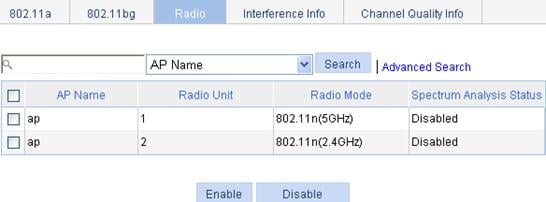
3. Select the radio for which spectrum analysis is to be enabled.
4. Click Enable.
Displaying interference device state
1. Select Radio > Spectrum Analysis from the navigation tree.
2. Click Interference Info.
You can view the non-802.11 interference devices detected by the AP.
Figure 24 Displaying interference device state

Table 20 Field description
|
Field |
Description |
|
Severity Index |
Interference severity level in the range of 1 to 100. A greater value indicates a stronger interference. |
|
Duty Cycle(%) |
Percentage of time for which the interference device was active. |
|
Signal Strength |
Signal strength of the detected interference device. |
Displaying channel quality information
1. Select Radio > Spectrum Analysis from the navigation tree.
2. Click Channel Quality Info.
Figure 25 Displaying channel quality information

Manual channel adjustment configuration example
Network requirements
As shown in Figure 26, configure manual channel adjustment on the AC so that the AC can perform manual channel adjustment when the channel of AP 1 is unavailable.

Configuration guidelines
If you select manual channel adjustment, click Channel Optimize on the Operation tab every time you perform manual channel adjustment.
Configuration procedure
1. Before you configure manual channel adjustment, configure AP 1 on the AC to establish a connection between them.
For the related configuration, see "Configuring access services."
2. Configure manual channel adjustment:
a. Select Radio > Calibration from the navigation tree.
b. Click the Parameters tab.
c. Select Manual from the Dynamic Channel Select list.
d. Click Apply.
Figure 27 Configuring manual channel adjustment

3. Perform manual channel adjustment:
a. Select Radio > Calibration from the navigation tree.
b. On the Operation tab, select the box of the target radio.
c. Click Channel Optimize.
Figure 28 Performing manual channel adjustment

Verifying the configuration
· You can view the channel status on the Operation tab you enter by selecting Radio > Calibration from the navigation tree.
· After you perform manual channel calibration, the AC informs the adjusted channel to the AP after a calibration interval.
· You can view the detailed information, such as the specific reason for channel adjustment on the History Info tab you enter by selecting Radio > Calibration from the navigation tree, clicking Operation, and then clicking History Info.
Automatic power adjustment configuration example
Network requirements
As shown in Figure 29, AP 1 through AP 3 are connected to the AC. Configure automatic power adjustment and specify the adjacency factor as 3 on the AC. In this way, when AP 4 joins, the AC performs automatic power adjustment to avoid interference.
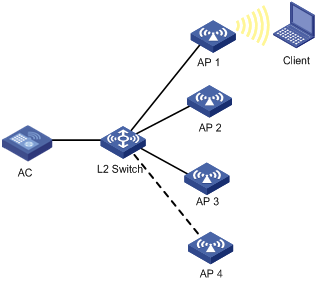
Configuration procedure
1. Before you configure automatic power adjustment, configure AP 1 through AP 4 on the AC to establish a connection between the AC and each AP.
For the related configuration, see "Configuring access services."
2. Configure automatic power adjustment:
a. Select Radio > Calibration from the navigation tree.
b. Click the Parameters tab.
c. Select Auto from the Dynamic Power Select list.
d. Click Apply.
Figure 30 Configuring automatic power adjustment
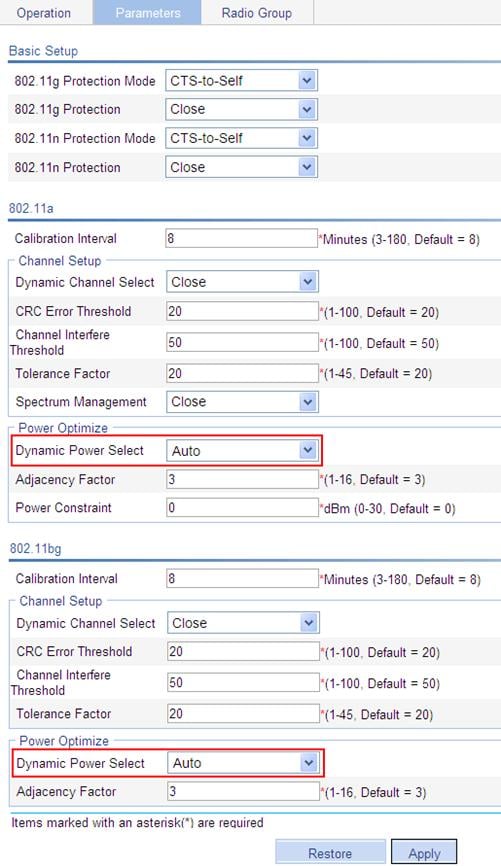
Verifying the configuration
· You can view the power of each AP on the Operation tab you enter by selecting Radio > Calibration from the navigation tree.
· When AP 4 joins (the adjacency number becomes 3), the maximum number of neighbors reaches the upper limit (3 by default), and the AC performs power adjustment after the calibration interval. You can view the detailed information, such as decrease of the Tx power value, on the History Info tab you enter by selecting Radio > Calibration from the navigation tree, selecting the Operation tab, and then selecting History Info.
Radio group configuration example
Network requirements
As shown in Figure 31, AP 1 through AP 3 are connected to the AC.
· Configure automatic channel adjustment so that the AC can automatically switch the channel when the signal quality on a channel is degraded to a certain level.
· Configure automatic power adjustment so that the AC can automatically adjust the power when the third neighbor is discovered (or in other words, when AP 4 joins) to avoid interference.
· Add radio 2 of AP 1 and radio 2 of AP 2 to a radio group to prevent frequent channel or power adjustments for the radios.

Configuration procedure
1. Before you configure a radio group, configure AP 1 through AP 4 on the AC to establish a connection between the AC and each AP.
For the related configuration, see "Configuring access services."
2. Configure automatic channel and power adjustment:
a. Select Radio > Calibration from the navigation tree.
b. Click the Parameters tab.
c. Select Auto from the Dynamic Channel Select list, select Auto from the Dynamic Power Select list, and click Apply.
Figure 32 Configuring automatic channel and power adjustment
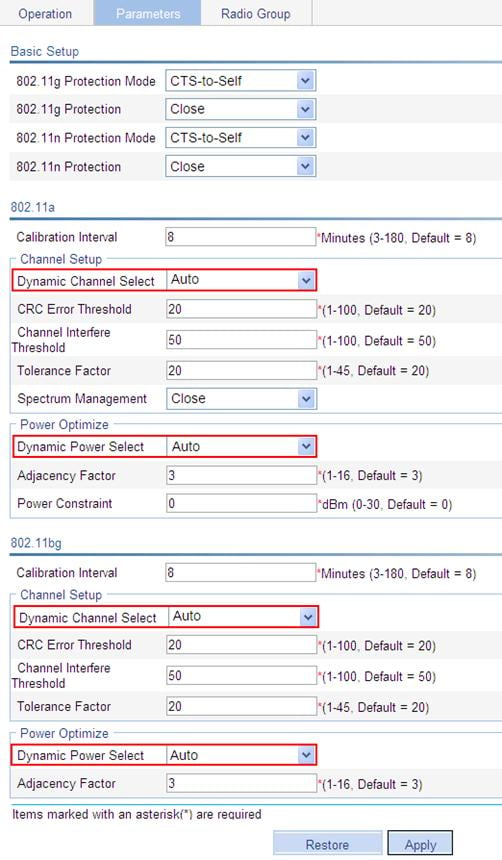
3. Configure a radio group:
a. Select Radio > Calibration from the navigation tree.
b. Click Radio Group.
c. Click Add.
d. On the page that appears, enter the channel holddown interval 20 and enter the power holddown interval 30.
e. In the Radios Available area, select the target radios and click << to add them into the Radios Selected area.
f. Click Apply.
Figure 33 Configuring the radio group

Verifying the configuration
· The working channel of radio 2 of AP 1 and the working channel of radio 2 of AP 2 do not change within 20 minutes after each automatic channel adjustment.
· The power of radio 2 of AP 1 and the power of radio 2 of AP 2 do not change within 30 minutes after each automatic power adjustment.
Spectrum analysis configuration example
Network requirements
As shown in Figure 34, AP 1 is operating in normal mode to provide WLAN access services. AP 2 is operating in monitor mode to detect interferences, channel quality, and FFT data. If AP 2 detects a microwave oven or bluetooth device, AP 2 notifies the AC, which sends alarms to the NMS.

Configuration procedure
1. Configure AP 1 to operate in normal mode. For more information, see "Configuring WLAN access."
2. Configure AP 2 to operate in monitor mode. For more information, see "Configuring WLAN security."
3. Enable spectrum analysis on a specified radio:
a. Select Radio > Spectrum Analysis from the navigation tree.
b. Click Radio.
Figure 35 Configuring radio

c. Select the radio with the radio mode 802.11n(2.4 GHz).
d. Click Enable.
4. Enable spectrum analysis globally on 2.4 GHz radios:
a. Select Radio > Spectrum Analysis from the navigation tree.
b. Click 802.11bg.
c. Enable spectrum analysis, disable channel quality trap (enabled by default), and keep Microwave oven and Bluetooth in the Trap on Device Types area (remove other devices from the area by selecting them and clicking >>).
d. Click OK.
Figure 36 Configuring spectrum analysis
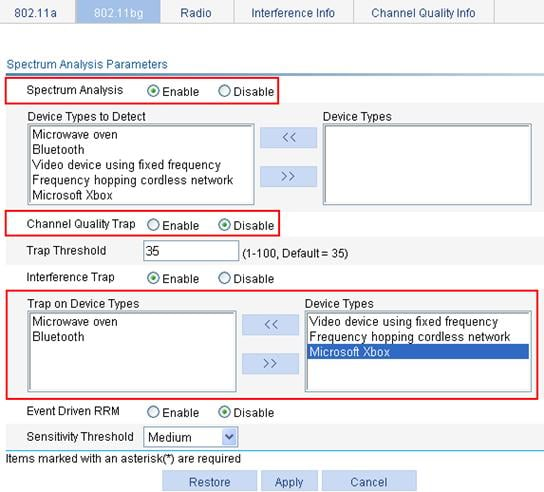
Verifying the configuration
· Select Radio > Spectrum Analysis from the navigation tree, and click Interference Info to display information about the non-802.11 interferences detected by AP 2.
· Select Radio > Spectrum Analysis from the navigation tree, and click Channel Quality Info to display channel quality information detected by AP 2.

